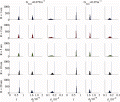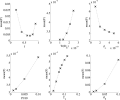Alexander, DC;
(2008)
A general framework for experiment design in diffusion MRI and its application in measuring direct tissue-microstructure features.
Magnetic Resonance in Medicine
, 60
(2)
439 - 448.
10.1002/mrm.21646.

Preview |
PDF
21646_ftp.pdf Download (453kB) |
![[thumbnail of GIF Figure 1]](https://discovery.ucl.ac.uk/136389/2.hassmallThumbnailVersion/tfig001.gif)  Preview |
Other (GIF Figure 1)
tfig001.gif Download (4kB) |
![[thumbnail of GIF Figure 2]](https://discovery.ucl.ac.uk/136389/3.hassmallThumbnailVersion/tfig002.gif)  Preview |
Other (GIF Figure 2)
tfig002.gif Download (5kB) |
![[thumbnail of GIF Figure 3]](https://discovery.ucl.ac.uk/136389/4.hassmallThumbnailVersion/tfig003.gif)  Preview |
Other (GIF Figure 3)
tfig003.gif Download (5kB) |
![[thumbnail of GIF Figure 4]](https://discovery.ucl.ac.uk/136389/5.hassmallThumbnailVersion/tfig004.gif)  Preview |
Other (GIF Figure 4)
tfig004.gif Download (3kB) |
Abstract
This article introduces a new and general framework for optimizing the experiment design for diffusion MRI of samples with unknown orientation. An illustration then uses the framework to study the feasibility of measuring direct features of brain-tissue microstructure in vivo. The study investigates the accuracy and precision with which we can estimate potentially important new biomarkers such as axon density and radius in white matter. Simulation experiments use a simple model of white matter based on CHARMED (composite hindered and restricted model of diffusion). The optimization finds acquisition protocols achievable on modern human and animal systems that consist of 120 measurements with fixed maximum gradient strengths. Axon radii in brain tissue are typically in the range 0.25-10 mu m. Simulations suggest that estimates of radii in the range 5-10 mu m have highest precision and that a maximum gradient strength of 0.07 T m(-1) is sufficient to distinguish radii of 5, 10, and 20 pm. Smaller radii are more difficult to distinguish from one another but are identifiable as small. A maximum gradient strength of 0.2 T m(-1) distinguishes radii of 1 and 2 mu m. The simulations also suggest that axon densities and diffusivity parameters in the normal range for white matter are recoverable. The experiment-design optimization has applications well beyond the current work to optimize the protocol for fitting any model of the diffusion process.
| Type: | Article |
|---|---|
| Title: | A general framework for experiment design in diffusion MRI and its application in measuring direct tissue-microstructure features |
| Open access status: | An open access version is available from UCL Discovery |
| DOI: | 10.1002/mrm.21646 |
| Publisher version: | http://dx.doi.org/10.1002/mrm.21646 |
| Language: | English |
| Additional information: | © 2008 Wiley-Liss, Inc. Full text made available to UCL Discovery by kind permission of Wiley. |
| Keywords: | quantitative MRI, diffusion MRI, microstructure, axon density, axon diameter, experiment design, Cramer-Rao lower bound, Rician noise, active imaging, brain white-matter, water diffusion, restricted diffusion, field-gradient, nmr microscopy, spin-echo, space, diffraction, model, parameters |
| UCL classification: | UCL UCL > Provost and Vice Provost Offices > UCL BEAMS UCL > Provost and Vice Provost Offices > UCL BEAMS > Faculty of Engineering Science UCL > Provost and Vice Provost Offices > UCL BEAMS > Faculty of Engineering Science > Dept of Computer Science |
| URI: | https://discovery.ucl.ac.uk/id/eprint/136389 |
Archive Staff Only
 |
View Item |


